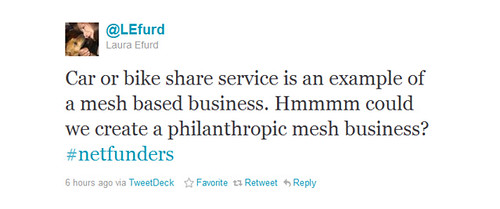
Guest Post by Stephen Downs
The Mesh
Laura Efurd sent this tweet during Lisa Gansky’s discussion of the mesh concept at the GEO Growing Social Impact in a Networked World conference. Great, provocative question. Gansky’s Mesh is based on the concept that unused value = waste and that information networks enable real-time brokering between customers and that unused capacity. So neighbors can share leaf lowers and snowblowers, companies can tap programmers for discrete jobs rather than everyone owning (or permanently employing) their own.
Philanthropic Functions
Efurd’s question demands an examination of the functions that philanthropies need to tap — functions that could be commoditized and procured and delivered over a network. A number of standard philanthropy business processes, like financial due diligence, come to mind. Obtaining expertise for peer review also comes to mind, though one could argue that that function has always been mesh-based in the sense that foundations tap experts that they don’t employ for short, just-in-time (on a good day) reviews. However, no one to my knowledge has organized a service/platform that would rapidly connect program officers needing reviews to suitable subject matter experts, who happen to be available, complete with a reputation management / feedback system. Are you listening LinkedIn?
On-demand Advocacy
Marty Kearns, of Netcentric Campaigns, has a more intriguing answer to Efurd’s question. Marty runs PreventObesity.net for the Robert Wood Johnson Foundation (my employer). The platform he’s building contains information on 60,000 people (the “base”) who are interested in advocating for a variety of policy changes to combat childhood obesity. Because there are numerous policy changes — ranging from removing sugar sweetened beverages from schools, to investing in supermarkets in food deserts, to adding sidewalks to residential areas — that can help to alleviate the problem, a variety of advocacy organizations, often with different and even non-overlapping purposes, can find value in engaging the base in their respective campaigns or calls to action. Rather than each of them building and maintaining their own lists, the advocacy organizations can use PreventObesity.net in an on-demand, mesh-like way.
The Importance of Scarcity
In my mind, one of the biggest obstacles to having mesh-based services for philanthropy is the lack of scarcity in philanthropy (or at least in the larger foundations). Scarcity, as the conference heard in the morning from Stephanie McAuliffe, can have a very positive effect — in her example producing a crucial collaboration to support post-abortion women in Pakistan. Scarcity can also drive people and organizations to mesh-based solutions. If such businesses are to emerge (and please — I’d love to know what might already be out there), foundations need pressure to be efficient. For smaller foundations this pressure might be more acute and that could create the needed demand. It would be interesting to see if larger foundations started to rent out their underutilized capacity to meet it.
Thanks Laura (and Lisa) for stimulating these thoughts. I’m sure I’ve only captured the tip of the iceberg of possibilities. What mesh businesses would others create for philanthropy?
Steve Downs is the chief technology and information officer at Robert Wood Johnson Foundation
